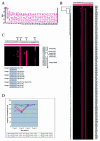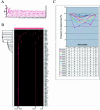Patterns of sequence conservation at termini of long terminal repeat (LTR) retrotransposons and DNA transposons in the human genome: lessons from phage Mu
- PMID: 12888514
- PMCID: PMC169890
- DOI: 10.1093/nar/gkg499
Patterns of sequence conservation at termini of long terminal repeat (LTR) retrotransposons and DNA transposons in the human genome: lessons from phage Mu
Abstract
Long terminal repeat (LTR) retrotransposons and DNA transposons are transposable elements (TEs) that perform cleavage and transfer at precise DNA positions. Here, we present statistical analyses of sequences found at the termini of precise TEs in the human genome. The results show that the terminal di- and trinucleotides of these TEs are highly conserved. 5'TG...CA3' occurs most frequently at the termini of LTR retrotransposons, while 5'CAG...CTG3' occurs most frequently in DNA transposons. Interestingly, these sequences are the most flexible base pair steps in DNA. Both the sequence preference and the degree of conservation of each position within the human LTR dinucleotide termini are remarkably similar to those experimentally demonstrated in transposable phage Mu. We discuss the significance of these observations and their implication for the function of terminal residues in the transposition of precise TEs.
Figures



Similar articles
-
Importance of the conserved CA dinucleotide at Mu termini.J Mol Biol. 2001 Nov 30;314(3):433-44. doi: 10.1006/jmbi.2001.5177. J Mol Biol. 2001. PMID: 11846557
-
The conserved CA/TG motif at Mu termini: T specifies stable transpososome assembly.J Mol Biol. 2003 Jul 4;330(2):261-75. doi: 10.1016/s0022-2836(03)00574-6. J Mol Biol. 2003. PMID: 12823966
-
Comprehensive analysis of the Xya riparia genome uncovers the dominance of DNA transposons, LTR/Gypsy elements, and their evolutionary dynamics.BMC Genomics. 2024 Jul 12;25(1):687. doi: 10.1186/s12864-024-10596-5. BMC Genomics. 2024. PMID: 38997681 Free PMC article.
-
Structural and sequence diversity of eukaryotic transposable elements.Genes Genet Syst. 2020 Jan 30;94(6):233-252. doi: 10.1266/ggs.18-00024. Epub 2018 Nov 9. Genes Genet Syst. 2020. PMID: 30416149 Review.
-
[Plant active LTR retrotransposons: a review].Sheng Wu Gong Cheng Xue Bao. 2016 Apr 25;32(4):409-429. doi: 10.13345/j.cjb.150279. Sheng Wu Gong Cheng Xue Bao. 2016. PMID: 28853263 Review. Chinese.
Cited by
-
Testing the palindromic target site model for DNA transposon insertion using the Drosophila melanogaster P-element.Nucleic Acids Res. 2008 Nov;36(19):6199-208. doi: 10.1093/nar/gkn563. Epub 2008 Oct 1. Nucleic Acids Res. 2008. PMID: 18829720 Free PMC article.
-
Jump ahead with a twist: DNA acrobatics drive transposition forward.Curr Opin Struct Biol. 2019 Dec;59:168-177. doi: 10.1016/j.sbi.2019.08.006. Epub 2019 Oct 5. Curr Opin Struct Biol. 2019. PMID: 31590109 Free PMC article. Review.
-
Transposable Phage Mu.Microbiol Spectr. 2014 Oct;2(5):10.1128/microbiolspec.MDNA3-0007-2014. doi: 10.1128/microbiolspec.MDNA3-0007-2014. Microbiol Spectr. 2014. PMID: 26104374 Free PMC article. Review.
-
Retroviral integrases promote fraying of viral DNA ends.J Biol Chem. 2011 Jul 22;286(29):25710-8. doi: 10.1074/jbc.M111.229179. Epub 2011 May 27. J Biol Chem. 2011. PMID: 21622554 Free PMC article.
-
DNA melting initiates the RAG catalytic pathway.Nat Struct Mol Biol. 2018 Aug;25(8):732-742. doi: 10.1038/s41594-018-0098-5. Epub 2018 Jul 30. Nat Struct Mol Biol. 2018. PMID: 30061602 Free PMC article.
References
-
- Kidwell M.G. and Lisch,D.R. (2000) Transposable elements and host genome evolution. Trends Ecol. Evol., 15, 95–99. - PubMed
-
- Kidwell M.G. and Lisch,D. (2002) Transposable elements as sources of genomic variation. In Craig,N.L., Craigie,R., Gellert,M. and Lambowitz,A.M. (eds), Mobile DNA II. American Society for Microbiology, Washington, DC, pp. 59–90.
-
- Lander E.S., Linton,L.M., Birren,B., Nusbaum,C., Zody,M.C., Baldwin,J., Devon,K., Dewar,K., Doyle,M., FitzHugh,W. et al. (2001) Initial sequencing and analysis of the human genome. Nature, 409, 860–921. - PubMed
-
- Doolittle W.F. and Sapienza,C. (1980) Selfish genes, the phenotype paradigm and genome evolution. Nature, 284, 601–603. - PubMed
-
- Orgel L.E. and Crick,F.H. (1980) Selfish DNA: the ultimate parasite. Nature, 284, 604–607. - PubMed
Publication types
MeSH terms
Substances
Grants and funding
LinkOut - more resources
Full Text Sources
Research Materials
Miscellaneous

